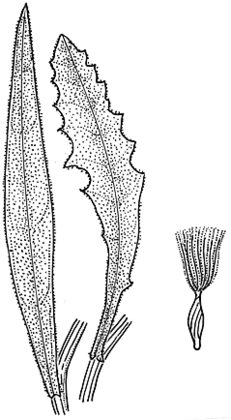Senecio prenanthoides A.Rich. APNI* Synonyms: Senecio sp. E sensu Jacobs & Pickard (1981) APNI*
Senecio sp. E sensu Harden (1992) APNI*
Senecio sp. E APNI*

Description: Erect perennial herb 20–80 cm high, cobwebby to ± glabrous, usually unbranched from base but sometimes much-branched.
Lowest leaves ± oblanceolate 5–10 cm long, 5–12 mm wide; middle leaves narrow-oblanceolate, 3–12 cm long, 2–6 mm wide, margins regularly toothed, upper surface sparsely cobwebby and often ± scabrous, lower surface ± cobwebby and often purplish, tapered into a petiole-like base.
Inflorescence corymbose, heads few to many; heads cylindrical, 1.5–2.5 mm diam., ± glabrous; involucral bracts 11–13, 6–7 mm long, with 2–4 longitudinal veins; bracteoles 2–6. Florets 25–35, scarcely longer than involucre; outer florets filiform; inner florets tubular.
Achenes 3–3.5 mm long, beaked, dark brown; pappus 6–7 mm long.
Flowering: chiefly spring–summer.
Distribution and occurrence: Grows in eucalypt woodland; widespread south from Byron Bay and Kyogle district.
NSW subdivisions: NC, CC, SC, NT, CT, ST, NWS, CWS, SWS
Other Australian states: Vic. Tas. W.A.
Text by G. J. Harden
Taxon concept: Flora of NSW 3 (1992) as Senecio sp. E.
APNI* Provides a link to the Australian Plant Name Index (hosted by the Australian National Botanic Gardens) for comprehensive bibliographic data
***The AVH map option provides a detailed interactive Australia wide distribution map drawn from collections held by all major Australian herbaria participating in the Australian Virtual Herbarium project.
|


